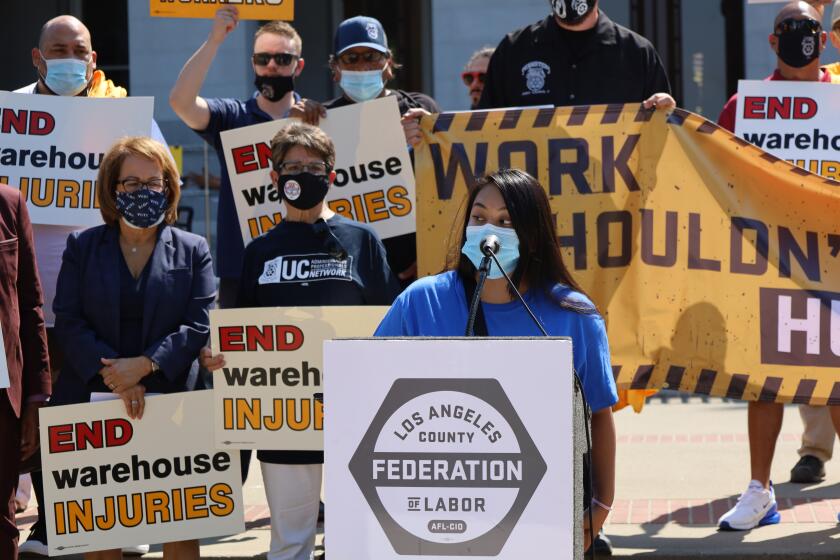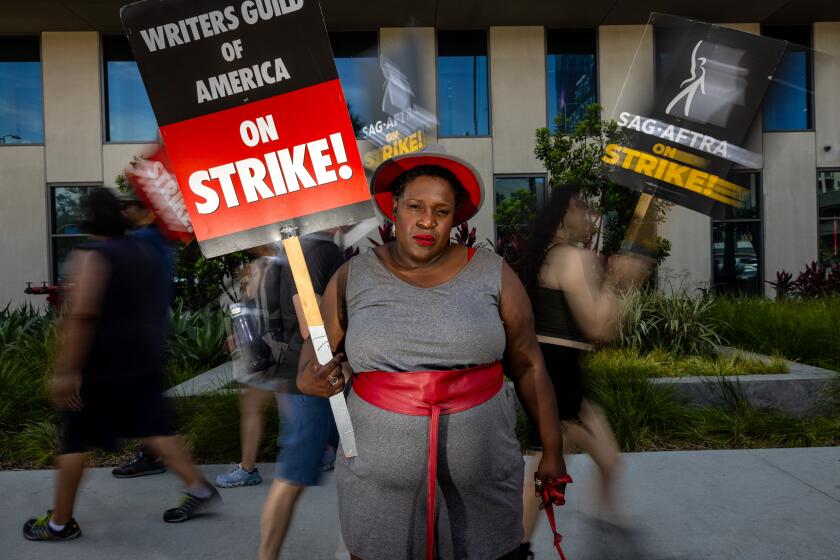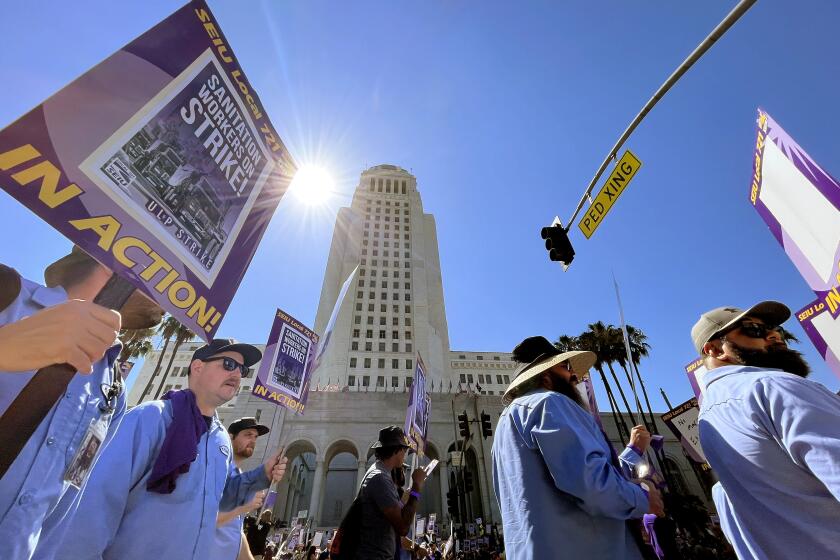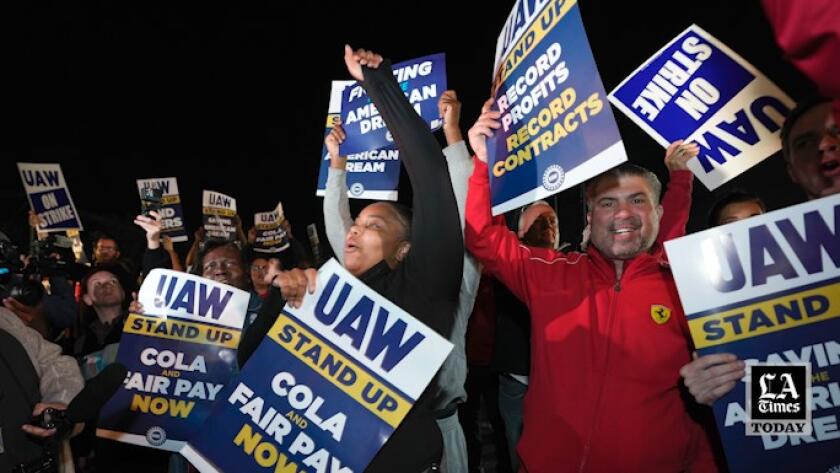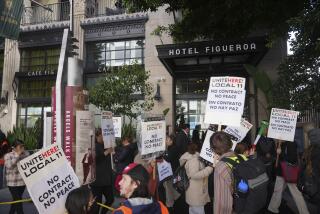Corporate greed, low unemployment, housing crisis: That’s the recipe for hot labor summer
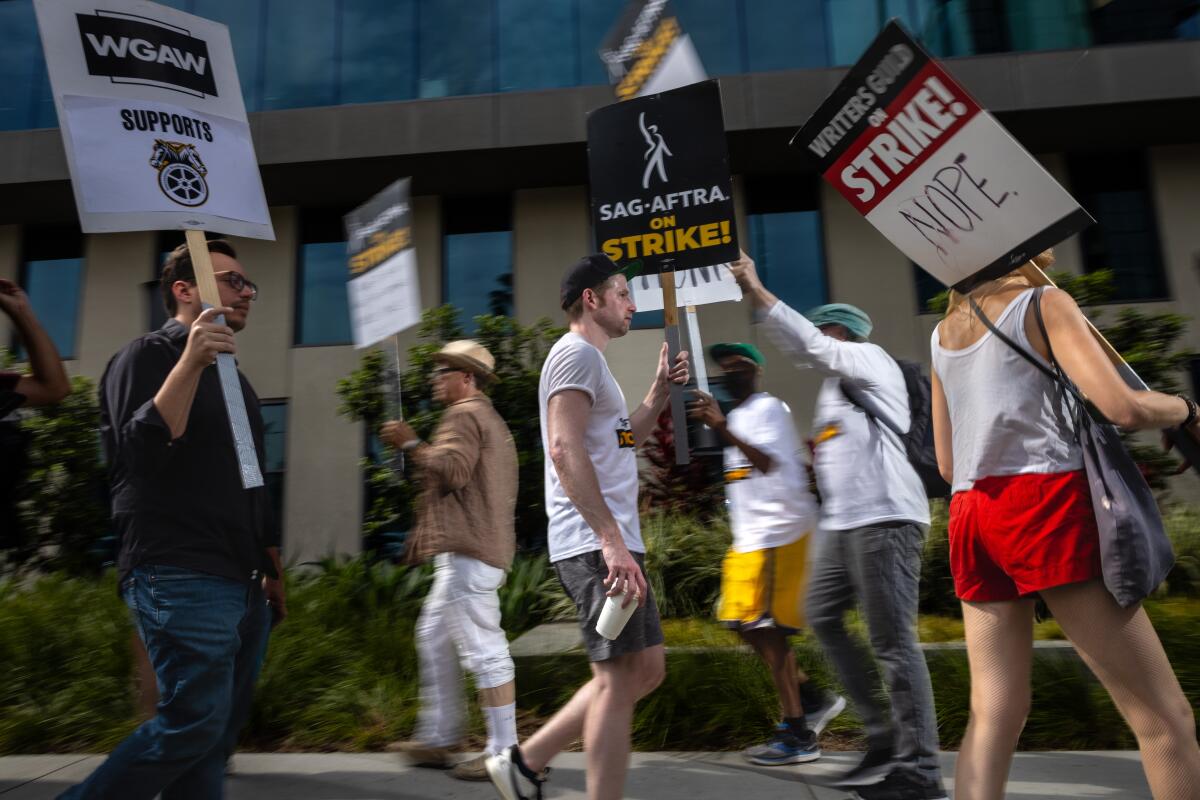
It’s hot, sweaty and built on solidarity: Los Angeles has become a city of picket lines this summer, with more than 100,000 workers out on strike in the region.
Each set of workers — screenwriters, actors, hotel employees, city staffers and more — is fighting its own particular fight, but organized labor is having a moment on the streets of L.A.
“There’s a perception that we have little in common, but we’re both fighting for our future,” playwright Sam Chanse said recently as she walked a picket line alongside hotel workers.
But is this hot labor summer just a perfect storm of organizing, economics and contract expiration? Or is this a new normal?
Strike activity in the U.S. has quadrupled since last year, and Los Angeles is the work stoppage capital for 2023, largely because of the huge number of L.A.-area writers and actors represented by the WGA and SAG-AFTRA unions.
Studio executives thought the world was their oyster. Unfortunately for the studios, that oyster has a few demands of its own.
Nationally, however, this level of labor action is a return to pre-pandemic form. More than 400,000 workers went on strike in both 2018 and 2019, which saw the “Red for Ed” teacher strikes and a major work stoppage at General Motors. This year’s picket population has topped 300,000 so far — but still has time to break a recent record, if the nearly 150,000 workers at the Big Three automakers go out on strike after their contracts expire in September.
On a longer time scale, the last decade has seen significantly less industrial action than most decades of the 20th century, when union membership was much higher across the U.S. And despite a wave of new union organizing at companies such as Starbucks and Amazon, workers have had a difficult time bargaining first contracts and fending off anti-union tactics from employers.
Still, it’s hard to deny that there’s something in the air this season. Johnnie Kallas, a doctoral candidate at Cornell University who runs the Cornell-ILR Labor Action Tracker, which keeps tabs on labor actions nationwide, points to the pandemic as a proximate cause.
“For a lot of these workers, this is the first contract that they’re negotiating since the beginning of the pandemic,” Kallas said.
Meanwhile, the cost of living has been jumping, which means even standard raises are still tantamount to pay cuts; corporate profits have been on the rise across the economy since 2020; and unemployment has remained low, giving workers more bargaining power.
That potent combination of factors, Kallas said, has made workers willing to fight.
“The pandemic had the effect of delegitimizing management in every which way,” said Nelson Lichtenstein, who teaches labor history at UC Santa Barbara.
Especially in the early days of the pandemic, managers “were discredited whether or not they tried to do the right thing,” Lichtenstein said. Office workers learned that they could have been working from home the whole time, even before lockdown rules made it necessary. “Essential workers,” who had to report to work in person, learned that their health was less important than the bottom line.
Hundreds of workers have died from extreme heat, but business lobbyists insist government rules aren’t necessary. Workers’ best hope for protection: unions.
Then, as the COVID-19 recession turned into a stock market boom, rising prices ate away at the spending power of the average employee while many of the companies they worked for reported strong earnings.
“Corporations lost their credibility,” Lichtenstein said, “and it was very intimate. It wasn’t something like a Madoff or big banks doing something. It was right there in everyone’s face.”
Los Angeles in particular sits at the vanguard of two trends: increasingly expensive housing and an increasing amount of cross-union solidarity.
Unite Here Local 11, the union representing workers on strike at dozens of hotels across the region, has explicitly tied its demands at the bargaining table to housing issues. In negotiations, the union has asked hotel owners to charge customers a new fee that would feed into a fund to help workers obtain affordable housing and support a 2024 ballot measure that would require Los Angeles hotels to rent vacant rooms to unhoused people.
The decades-long decay in regular residual payments and show staffing has also put housing costs front and center for writers and actors who are on strike.
Four actors on why they’re striking and the struggle to maintain a middle-class living in today’s Hollywood.
Even a group representing local businesses agrees that housing costs are contributing to labor unrest.
Maria Salinas, president of the Los Angeles Area Chamber of Commerce, said that her group is “very concerned about the affordability issues, mainly in housing” and that it advocates for regulatory changes to increase housing construction.
According to a recent informal poll of about 100 chief executives, Salinas said, “the top issue was housing affordability, followed by tightness in the labor market,” both of which are making it difficult to recruit and retain workers in Los Angeles.
Kent Wong, director of the UCLA Labor Center, noted that housing costs also motivated the statewide UC graduate student worker strike last year, with workers facing “tremendous difficulty making ends meet, especially given the rising cost of housing.”
“The other major factor is that Los Angeles is an important focal point for the new American labor movement,” Wong said. Since Miguel Contreras assumed the leadership of the L.A. County Federation of Labor in the mid-1990s, the local labor movement has been at the forefront of organizing immigrant workers, nonunion workers and young workers across industries to push for political change, such as raising the minimum wage to $15 an hour and beyond.
What’s happening now feels different. There’s a level of cross-union support across radically different workplaces, along with a knowledge of one another’s respective struggles, that I’ve never seen, or frankly ever thought possible.
The L.A. labor movement is working together more than it has in past years. In March, L.A. schoolteachers represented by United Teachers Los Angeles coordinated a joint three-day strike with L.A. school workers represented by SEIU Local 99. Within weeks of the joint action, both unions secured contracts with major raises — 21% for the teachers and 30% for the workers represented by SEIU. This year is also the first time since 1960 that screenwriters and actors are simultaneously on strike, and the local Teamsters have committed to honoring their picket lines.
But still, organized labor in the U.S. is relatively weak compared with earlier decades — and efforts to organize new groups of workers and get them under union contracts have faced stiff opposition from employers.
“Normally when you think of moments of mobilization and discrediting of the old order, from the ‘30s to the ‘60s and ‘70s, organization expands,” Lichtenstein said. “But right now that’s not happening.”
California voters complain that canvassers for a measure to repeal a law expanding protections for fast-food workers lied about the effects.
To explain the gap, Lichtenstein points to weaker labor laws and management hostility.
“The management strategy now is basically to not recognize the union and wait it out, even if they take a reputational hit, and that’s often successful,” Lichtenstein said. “The playbook works, given the current state of the labor laws,” which hit employers with small penalties for violations and have little power to force employers to the bargaining table.
“In this country, management is very antagonistic to the idea of unions and collective bargaining, even when it could be in their interest or lead to good outcomes,” said Kallas, the Cornell researcher. Starbucks workers, for instance, have organized unions at more than 300 coffee shops, but the company has waged an intense campaign to avoid recognizing them or bargaining a first contract.
But if hardball tactics from management keep colliding with a workforce that’s losing purchasing power, losing their homes and losing their patience, then workers could keep organizing and keep resorting to strikes when negotiations fall apart.
The summer’s strikes are a reflection of “an upsurge in worker consciousness and a reflection of a deep dissatisfaction with a status quo that is not working for most workers,” Wong said.
Wong added that economic inequality in California grew during the pandemic despite the ostensibly pro-labor makeup of the state government. “More workers are seeing the necessity of organizing, mobilizing and fighting for better wages and conditions at the work site.”
Watch L.A. Times Today at 7 p.m. on Spectrum News 1 on Channel 1 or live stream on the Spectrum News App. Palos Verdes Peninsula and Orange County viewers can watch on Cox Systems on channel 99.
More to Read
Inside the business of entertainment
The Wide Shot brings you news, analysis and insights on everything from streaming wars to production — and what it all means for the future.
You may occasionally receive promotional content from the Los Angeles Times.

